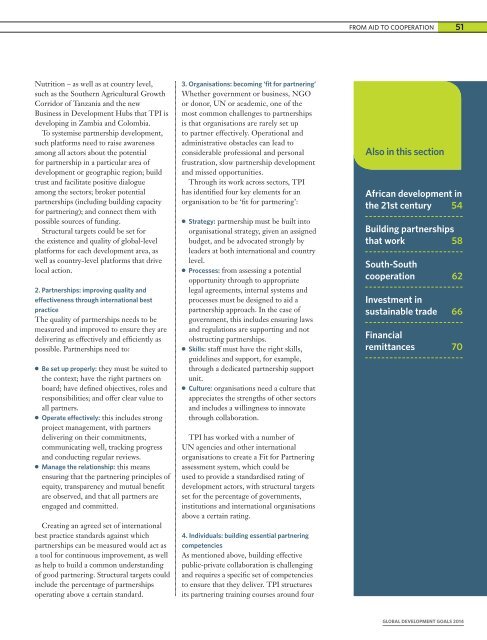FAMBB
FAMBB
FAMBB
You also want an ePaper? Increase the reach of your titles
YUMPU automatically turns print PDFs into web optimized ePapers that Google loves.
FROM AID TO COOPERATION51Nutrition – as well as at country level,such as the Southern Agricultural GrowthCorridor of Tanzania and the newBusiness in Development Hubs that TPI isdeveloping in Zambia and Colombia.To systemise partnership development,such platforms need to raise awarenessamong all actors about the potentialfor partnership in a particular area ofdevelopment or geographic region; buildtrust and facilitate positive dialogueamong the sectors; broker potentialpartnerships (including building capacityfor partnering); and connect them withpossible sources of funding.Structural targets could be set forthe existence and quality of global-levelplatforms for each development area, aswell as country-level platforms that drivelocal action.2. Partnerships: improving quality andeffectiveness through international bestpracticeThe quality of partnerships needs to bemeasured and improved to ensure they aredelivering as effectively and efficiently aspossible. Partnerships need to:●●Be set up properly: they must be suited tothe context; have the right partners onboard; have defined objectives, roles andresponsibilities; and offer clear value toall partners.●●Operate effectively: this includes strongproject management, with partnersdelivering on their commitments,communicating well, tracking progressand conducting regular reviews.●●Manage the relationship: this meansensuring that the partnering principles ofequity, transparency and mutual benefitare observed, and that all partners areengaged and committed.Creating an agreed set of internationalbest practice standards against whichpartnerships can be measured would act asa tool for continuous improvement, as wellas help to build a common understandingof good partnering. Structural targets couldinclude the percentage of partnershipsoperating above a certain standard.3. Organisations: becoming ‘fit for partnering’Whether government or business, NGOor donor, UN or academic, one of themost common challenges to partnershipsis that organisations are rarely set upto partner effectively. Operational andadministrative obstacles can lead toconsiderable professional and personalfrustration, slow partnership developmentand missed opportunities.Through its work across sectors, TPIhas identified four key elements for anorganisation to be ‘fit for partnering’:●●Strategy: partnership must be built intoorganisational strategy, given an assignedbudget, and be advocated strongly byleaders at both international and countrylevel.●●Processes: from assessing a potentialopportunity through to appropriatelegal agreements, internal systems andprocesses must be designed to aid apartnership approach. In the case ofgovernment, this includes ensuring lawsand regulations are supporting and notobstructing partnerships.●●Skills: staff must have the right skills,guidelines and support, for example,through a dedicated partnership supportunit.●●Culture: organisations need a culture thatappreciates the strengths of other sectorsand includes a willingness to innovatethrough collaboration.TPI has worked with a number ofUN agencies and other internationalorganisations to create a Fit for Partneringassessment system, which could beused to provide a standardised rating ofdevelopment actors, with structural targetsset for the percentage of governments,institutions and international organisationsabove a certain rating.4. Individuals: building essential partneringcompetenciesAs mentioned above, building effectivepublic-private collaboration is challengingand requires a specific set of competenciesto ensure that they deliver. TPI structuresits partnering training courses around fourAlso in this sectionAfrican development inthe 21st century 54Building partnershipsthat work 58South-Southcooperation 62Investment insustainable trade 66Financialremittances 70GLOBAL DEVELOPMENT GOALS 2014


